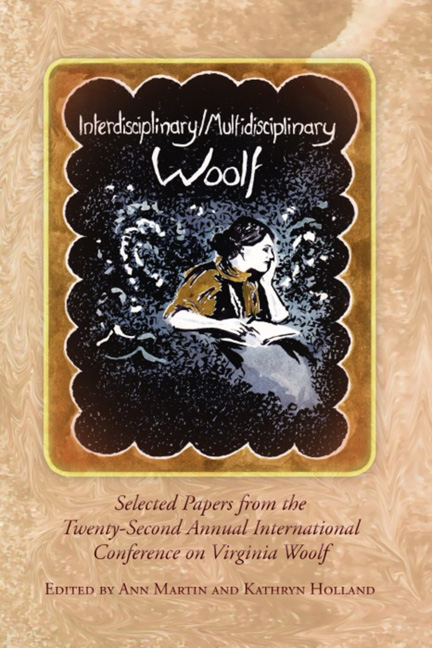Book contents
- Frontmatter
- Contents
- Introduction to Interdisciplinary/Multidisciplinary Woolf
- Acknowledgments
- List of Abbreviations
- History, Materiality, Multiplicity
- Patterns, Practices, Principles
- “Waving to Virginia”
- Woolf, Defoe, Derrida: Interdisciplinary dogs—or the canine aesthetics and (gender) politics of creativity
- “The law is on the side of the normal”: Virginia Woolf as Crip Theorist
- A Healing Centre of One's Own: Woolf's Legacy and Public Responses to Child Abuse
- Sunflower Suture: Disseminating the Garden in The Years
- “One Must Be Scientific”: Natural History and Ecology in Mrs. Dalloway
- Clarissa's Glacial Skepticism: John Tyndall and “Deep Time” in Mrs. Dalloway
- Apollonian Illusion and Dionysian Truth in Mrs. Dalloway
- Art, Influence, Embodiment
- Publishing, Politics, Publics
- Notes on Contributors
- Conference Program
“Waving to Virginia”
from Patterns, Practices, Principles
- Frontmatter
- Contents
- Introduction to Interdisciplinary/Multidisciplinary Woolf
- Acknowledgments
- List of Abbreviations
- History, Materiality, Multiplicity
- Patterns, Practices, Principles
- “Waving to Virginia”
- Woolf, Defoe, Derrida: Interdisciplinary dogs—or the canine aesthetics and (gender) politics of creativity
- “The law is on the side of the normal”: Virginia Woolf as Crip Theorist
- A Healing Centre of One's Own: Woolf's Legacy and Public Responses to Child Abuse
- Sunflower Suture: Disseminating the Garden in The Years
- “One Must Be Scientific”: Natural History and Ecology in Mrs. Dalloway
- Clarissa's Glacial Skepticism: John Tyndall and “Deep Time” in Mrs. Dalloway
- Apollonian Illusion and Dionysian Truth in Mrs. Dalloway
- Art, Influence, Embodiment
- Publishing, Politics, Publics
- Notes on Contributors
- Conference Program
Summary
Part 1.
Where to begin? Perhaps with an origins story. The original title for my project was “‘Waving to Virginia’: Gay Men, AIDS, Suicide, and Woolf.” The starting point was Julian Schnabel's 2000 film Before Night Falls, based on the autobiography of the Cuban writer Reinaldo Arenas; in December 1990, dying of AIDS and unable to write any longer, Arenas committed suicide in his New York apartment. Watching the film with my neighbors I had one of those moments that have led my friends to accuse me of seeing Woolf everywhere. In the last scene, just before the suicide, a friend enters the apartment carrying an “I NY” plastic bag that will shortly be used to facilitate his death. The friend goes into the study, bends down, and there, on the wall behind him, is the Man Ray portrait of Woolf with her arm raised in the air. “That's Virginia Woolf,” I said; “you're seeing things,” my husband and neighbors responded. So I took the film home and froze the scene: yes, it was Virginia Woolf.
The next thing I did, of course, was to google “Reinaldo Arenas / Virginia Woolf,” where I found an article written to coincide with the release of the film by Octavio Roca, another Cuban artist, called “Remembering Reinaldo.” Among his memories appears the following: “I remember the clutter of his little apartment, the piles of books and the pictures of Cuba. Above his desk were photos of his literary idols: Virginia Woolf, Marcel Proust and Virgilio Piñera. I remember his gentleness.” Piñera was one of Arenas's mentors in Cuba; I'll return to him.
At that point I began to bother my friends who teach Latin American and/or Cuban literature, who put me in touch with others in the field. From these exchanges I learned that yes, Arenas was intertwined with Woolf, especially Orlando, both the novel and the character, who, I later discovered, appears in her female form in Arenas's own picaresque quasi-historical novel Hallucinations (El mundo alucinante); more enigmatically, a tongue twister about Virginia Woolf appears in his novel The Color of Summer (Color del verano).
- Type
- Chapter
- Information
- Interdisciplinary/Multidisciplinary Woolf , pp. 80 - 94Publisher: Liverpool University PressPrint publication year: 2013

